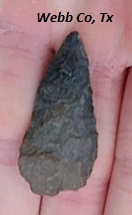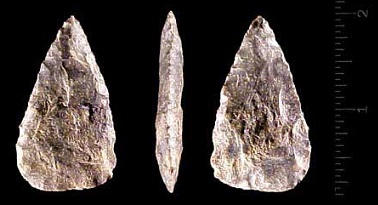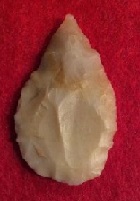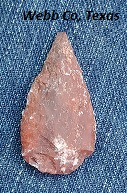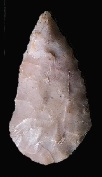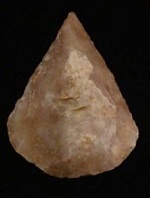Outline is Representative of Size and Shape:

Name Details:
Identified By: Richard "Scotty" MacNeish
Named For:
Date Identified: 1958
Type Site:
Identified By: Richard "Scotty" MacNeish
Named For:
Date Identified: 1958
Type Site:
Point Validity:
Valid type
MacNeish was a pioneering anthropologist who was most notable for his excavations and studies at Tamaulipas Mexico. This type has been references in professional publications and is considered a valid type
MacNeish was a pioneering anthropologist who was most notable for his excavations and studies at Tamaulipas Mexico. This type has been references in professional publications and is considered a valid type
Catan Triangular
Cluster: Late Southern Triangle Cluster Description of Physical Characteristics and Flaking Pattern:
This is a small triangular to ovoid point with a flattened to elliptical cross section. The blade is excurvate and commonly beveled on one or both faces. The base is convex with rounded basal corners forming a semicircular appearance. The base is commonly thinned with the removal of one or two broad flakes. This point is primarily manufactured using percussion flaking leaving a random flaking pattern.
Size Measurements:
Length - 20 to 44 mm (average 45 mm), Width - 15 to 38 mm (average 28 mm), Thickness - 5 to 10 mm (average 7 mm)
Length - 20 to 44 mm (average 45 mm), Width - 15 to 38 mm (average 28 mm), Thickness - 5 to 10 mm (average 7 mm)
Commonly Utilized Material:
Additional Comments:
The Catan point is similar to the Abasolo point, only smaller (Turner and Hester, 1985). Catan points range from 20 to 40 mm while the Abasolo ranges from 40 to 60 mm (Suhm and Kreiger, 1954).
The Catan point is similar to the Abasolo point, only smaller (Turner and Hester, 1985). Catan points range from 20 to 40 mm while the Abasolo ranges from 40 to 60 mm (Suhm and Kreiger, 1954).
Distribution: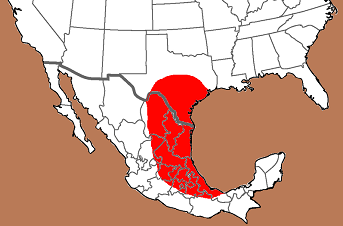

Distribution Comments:
This point is primarily found in the Rio Grande drainage of Texas and into southern Tamaulipas and eastern Nuevo Leon Mexico and into Oaxaca, Tehuacan Valley, Cueva de la Nopalera, Hidalgo, and the Valley of Mexico. This point is found with decreasing frequency into the coastal regions and central Texas.
Age / Periods:
Date: 2,500 - 500 B.P.
Cultural Period: Transitional Archaic to Late
Prehistoric
Glacial Period: Neoglacial to Little Ice Age
Culture:
Date: 2,500 - 500 B.P.
Cultural Period: Transitional Archaic to Late
Prehistoric
Glacial Period: Neoglacial to Little Ice Age
Culture:
Age Details:
At Cueva de la Nopalera these points were found equally distributed in levels 4, 3, and 2.
At Cueva de la Nopalera these points were found equally distributed in levels 4, 3, and 2.
Similar Points:
Abasolo, Catan, Cottonwood Leaf, Fresnito, Fresno, Guerrero, Matamoros, Padre, Young
Abasolo, Catan, Cottonwood Leaf, Fresnito, Fresno, Guerrero, Matamoros, Padre, Young
Other points in this cluster / Related / Associated Points:

